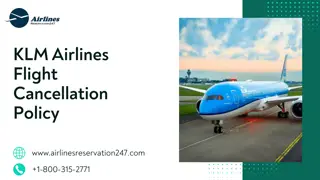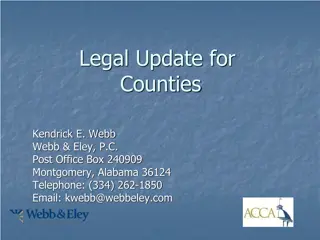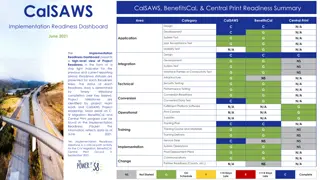University of South Alabama Flight Readiness Review Details
Detailed information on the flight readiness review of the University of South Alabama rocket project, including final launch vehicle parameters, key design features, rocket motor specifications, flight stability analysis, thrust-to-weight ratio, recovery parameters, kinetic energy calculations, and predicted drift and altitude of the vehicle. The review covers essential aspects such as rocket dimensions, hazardous detection capabilities, turbine energy conversion, motor performance, stability metrics, mass statement, recovery systems, and kinetic energy distribution across various phases of flight.
Download Presentation

Please find below an Image/Link to download the presentation.
The content on the website is provided AS IS for your information and personal use only. It may not be sold, licensed, or shared on other websites without obtaining consent from the author.If you encounter any issues during the download, it is possible that the publisher has removed the file from their server.
You are allowed to download the files provided on this website for personal or commercial use, subject to the condition that they are used lawfully. All files are the property of their respective owners.
The content on the website is provided AS IS for your information and personal use only. It may not be sold, licensed, or shared on other websites without obtaining consent from the author.
E N D
Presentation Transcript
Flight Readiness Review UNIVERSITY OF SOUTH ALABAMA CONNER DENTON, JOHN FAULK, NGHIA HUYNH, KENT LINO, PHILLIP RUSCHMYER, & ANDREW TINDELL MENTOR : RICHARD KRAMER
Final Launch Vehicle Parameters Overall Vehicle Parameters Rocket height: 94 inches Body diameter: 4 inches Wall thickness: 1/16 inch Nosecone: Ogive Fin design: Straight Tapered
Key Design Features Hazard Detection Camera capable of spotting hazardous areas through point of view analysis Turbine Energy Conversion on board turbine generator capable of converting energy sufficient for on board electronics
Final Rocket Motor AeroTech K1103X - 14 Total Impulse: 1789 N Pre Burn Mass: 1459 g Post Burn Weight:
Rocket Flight Stability Flight Stability: 2.49 cal CP (Simulated): 73.621 inches from nose CG (Experimental): 63.659 inches from nose
Thrust to Weight Ratio Thrust to Weight Ratio: 16.05 Thrust: 1103 N Weight: 247 oz. -> 7.00 kg -> 68.69 N Rail exit velocity: 101 ft/s Thrust curve of Aerotech K1103 motor.
Recovery Parameters Drogue Parachute Size: 12 inches Main Parachute Size: 72 inches Calculated Descent Rates: Rocket body under drogue (white): 139.44 ft/s Rocket body under main (pink) : 23.24 ft/s
Kinetic Energy Calculations Phases Take-off Deployment Landing Nosecone 86.10 ft-lbf 149.30 ft-lbf 3.90 ft-lbf Avionics Bay 894.63 ft-lbf 1551.32 ft-lbf 40.54 ft-lbf Booster Bay 1466.39 ft-lbf 2542.79 ft-lbf 66.45 ft-lbf
Predicted Drift and Altitude of Vehicle Predicted drift from launch pad: Predicted altitude from launch pad 5mph 220.87 ft. 5mph 5407 ft. 10mph 441.74 ft. 10 mph 5372 ft. 15mph 662.61 ft. 15 mph 5337 ft. 20mph 883.48 ft. 20 mph 5312 ft.
Final Payload Design & Dimensions Turbine Schematic Ground connection Analog input connection Pixy Camera Schematic ICSP connection
Final Payload Design & Dimensions Turbine Tray Secured in G10 fiberglass bay Stationary in booster bay Pixy Camera Tray Need to design Pixy Camera Tray Secured in G10 fiberglass bay Plexiglass bulkhead
Payload Integration Vehicle Attachment Scheme Main Parachute (A): Deploy at approximately 700ft Nosecone (B): Will deploy with main parachute Avionics Bay (C): Houses hazard detection camera, altimeter, and parachute until apogee Booster Bay (D): Houses shock cord, motor, and turbine generation payload DC Wind Turbine (D): Housed in booster bay Turbine tray: round with spokes Directed air flow piping Hazard Detection Camera (F): Located in coupler G10 Fiberglass Bay & Bulkhead Plexiglass Bulkhead
Interfaces with Ground Systems Stratologger #1: Will deploy both main designated altitude and drogue at apogee Stratologger #2: Designated as scoring competition altimeter PixyCam: Hazard detection payload capable of determining position away from descending vehicle Turbine Generator: Generates and logs the amount of current produced in order to prove that it can be used it further projects to power on board electronics
Payload Test Plan Hazard Detection Pixy Camera Failsafe Drogue Deployment Turbine Full scale turbine voltage test with air jet Test outside in normal climate conditions Hinderance of weather conditions Multimeter voltage testing Arduino Uno data logging Effects of sunlight Wind Tunnel Testing Further equation accuracy testing Airflow scoop stability Uniquely colored tarp for color ID Velocity of interior air flow Camera coordinates Voltage testing Absolute coordinates Directed airflow piping Full scale testing Determine optimum piping positioning Max voltage allowance Ejection from avionics bay Tangling with shock cord Tilt during descent Plexiglass clarity
Recovery System Tests Black Powder Charge Ejection Tests ~2.0 grams (unsuccessful) ~2.5 grams (successful) Altimeter Tests Vacuum testing Electrical disturbances Aluminum tape
Full Scale Flight Tests First Full Scale Flight: Apogee: 3507 ft. Deployment: Dual with main parachute at 700 ft Overloaded black powder charge so both parachutes deployed at apogee Second Full Scale Flight: Apogee: 2203 ft. Deployment: Dual with main parachute at 700 Successful launch and recovery Full scale test flight.
Summary of Launch Vehicle Requirement Verification Successful sub-scale launch Safe full-scale launch Static ground testing OpenRocket simulations Future parachute drag analysis
Summary of Payload Requirement Verification Sub-scale mass simulations Full-scale mass simulations Static ground testing Wind tunnel testing Drop testing of camera bay Air jet testing of wind turbine























